
The Global Hibakusha Project: Nuclear Post-colonialism and its Intergenerational Legacy
by MICK BRODERICK and ROBERT JACOBS
- View Mick Broderick's Biography
Mick Broderick is a cultural practitioner and academic based at Murdoch University, Perth.
- View Robert Jacobs' Biography
Robert Jacobs is a historian of nuclear technologies and radiation technopolitics and Professor at the Hiroshima Peace Institute and Hiroshima City University.
The Global Hibakusha Project: Nuclear Post-colonialism and its Intergenerational Legacy
Mick Broderick and Robert Jacobs
Introduction
The survivors of the two nuclear attacks on Hiroshima and Nagasaki at the end of World War Two in 1945 are known as 'hibakusha': the term literally means explosion-affected person. However, less than one year after the nuclear attacks, nuclear weapons were again being detonated -- this time, two weapons tested by the United States in the Marshall Islands, a territory under U.S. control in the aftermath of the war and collapse of the Japanese empire. These two tests would be the first of 67 nuclear tests conducted in the Marshall Islands, part of the current total of over 2,000 nuclear weapon tests worldwide. Nuclear weapons would be tested by the nuclear weapon states on every continent except for South America and Antarctica.
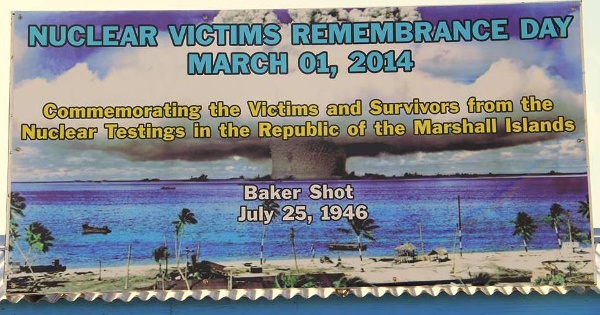
1) Large public banner for the 60-year anniversary commemoration on 1 March 2014 of the 15Mt Bravo thermonuclear test that contaminated several atolls of the Marshall Islands. Photo: Mick Broderick.
Most academic work related to the history of nuclear testing and radiation exposure has been either epidemiological, tracking the health impacts of those exposed to radiation, or environmental, tracking the migration of radionuclides through the ecosystem after deposition from radioactive fallout clouds. What little academic inquiry there has been on the social impacts of this history have typically been confined to examining communities strictly in terms of the nuclear weapon state that irradiated the community, i.e., studies of victims of French nuclear testing, or of US nuclear testing. The Global Hibakusha Project (GHP) is a research project that grew out of the desire to understand this history, and the non-epidemiological impacts of radiation exposures, freed from this nationalistic frame. In addition to this scholarly goal, we also sought to find a way to link disparate hibakusha communities together for purposes of solidarity and information sharing. Several years into the GHP, the work dovetailed with the activities of the Nuclear Futures Partnership Initiative (see Brown 2018 in this volume) through community development activities with an international cohort of young people from atomic survivor communities.
Global Hibakusha Project Purpose
After meeting in Chicago and Hiroshima in 2006 and 2007 at two nuclear culture symposia arranged by the Hiroshima Peace Institute, the authors received a small seed-funding grant in 2008 from Murdoch University to pursue collaborations and major grant applications. At that time one of the prominent gaps in the scholarship investigating nuclearism was a lack in cross-cultural, historical analysis of the international impact of cold war atmospheric nuclear testing. While there had been epidemiological and ecological studies across differing irradiated cohorts, and individual studies of cultural impacts on specific, individual hibakusha communities there was little done to connect these disparate cohorts.1
Based on our previous oral history work and visits to nuclear sites (Monte Bello Islands (2002), Alamagordo (2004), Maralinga (2005-09), Nevada (2010), Hiroshima and Nagasaki (2005-09), we began researching ways to scope the field and arrange introductions to affected communities. Conscious of its specific Japanese legacy, we adopted our project name "global hibakusha" from observations that atmospheric nuclear testing had contaminated much of the world's cold war population with Stontium-90 and other radionuclides, making us "all hibakusha".2
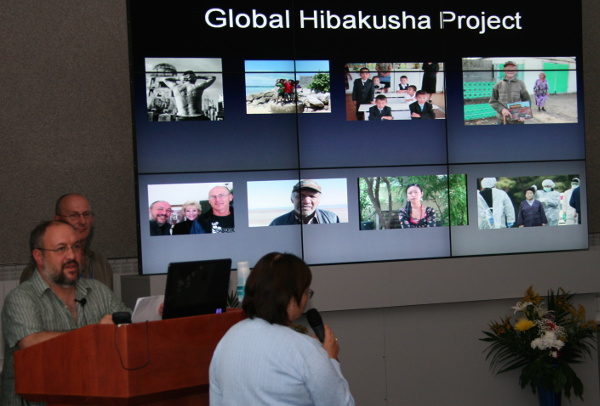
2) The authors (at left) in 2012 presenting a paper on the Global Hibakusha Project from inside the former Soviet nuclear test site "the Polygon" at Kurchatov, Kazakhstan.
In 2010 Hiroshima City University funded a two-year study to "establish links between Hibakusha communities at nuclear test sites", which was soon superseded in 2011 with an expanded, three-year Japanese government Kaken-hi grant, coincidentally awarded in the weeks following the disaster at Fukushima. We suggested that by using the new affordances of evolving social media networks and cheap smartphones and tablets, that virtual communities of global hibakusha (inclusive of dispossessed indigenous communities, nuclear veterans, civilian workers and 'downwinders') could be established to digitally record, preserve and potentially share their respective histories. We envisioned this networking could help enable communities to better control access and dissemination of their own narratives, experiences and cultures rather than it being mediated by (mostly) western academic or media gatekeepers. Our intention was to create opportunities for communal solidarity between these disparate (and often isolated) groups where they could share local knowledge to help in understanding the ongoing impacts of nuclear testing, and discover what legal precedents, reparations and declassification of documents existed to better serve their quest for acknowledgment and/or compensation.
Project Design
From the start we were aware that our project depended on oral history interviews conducted in the field with members of radiation-affected communities. We also understood that we could not assume that we would be received in such communities as neutral observers collecting data. The long histories of colonialism, both internal and external, that had resulted in these sites being used to test nuclear weapons left legacies additional to those of radiological contamination (Jacobs 2013). However, we construed our intentions, we were still just two more in a long line of 'white guys' with microphones showing up to extract one last resource: stories. Cognisant of this we knew we had to work through existing traditional structures in each community such as elders, activist groups and community hierarchies.
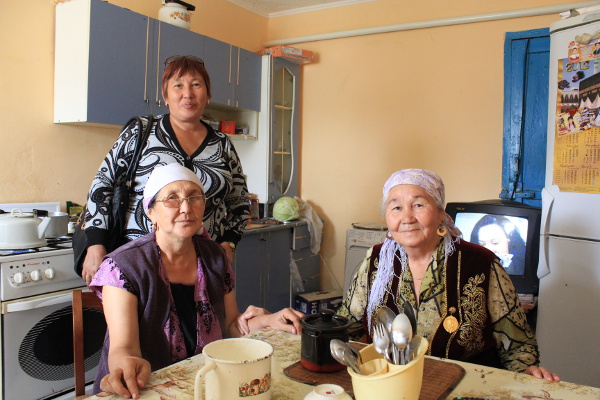
3) Three generations of Kazakh women interviewed in 2012 for the Global Hibakusha Project, at a downwind home adjacent the Polygon test site. Photo: Mick Broderick.
On our first visits to various sites, we worked to establish bonds with community leaders and explain our goals and methods and did not seek to conduct any interviews until return trips. These methods included ensuring that people who chose to share their stories with us retained intellectual property rights over the interviews, videos and photographs. We would be unable to use any part of these materials without the explicit consent of the interviewee, and we would provide copies of any outcomes to those cited. Additionally, we sought to share both stories and research outcomes across communities, recognising that information had also become a colonised commodity in many locations (Nader and Gusterson 2007).
With these protocols established, we began visits to communities located nearby to nuclear test sites, production sites and accident sites. We also conducted interviews with other cohorts of irradiated communities such as soldiers who took part in their national nuclear testing programs, labourers employed at test sites, and scientific and technical support staff. Because of our language limitations, we employed translators for many interviews, which were also recorded for subsequent, more detailed translation.
Project Practice
Our first Global Hibakusha field trip took us to Russia and Kazakhstan in 2010. Seeking to meet with Russian nuclear veterans we were surprised that an environmental NGO in Moscow introduced us to a former KGB Colonel; the scientist and senior administrator of the Soviet nuclear test program, Vadim A. Logachev. We had earlier sent a generic project description (translated into Russian) that clearly articulated our objectives to connect hibakusha communities world-wide that had been adversely affected by fallout and removed from traditional lands. Logachev was charming but unrepentant, producing detailed maps and declaring that no fallout from Soviet tests contaminated neighbouring Kazakh villages. The next week in Kazakhstan was a different matter. In Semey (formerly Semipalatinsk), we visited the cancer hospital that had been treating local hibakusha for decades and was referred to academic Professor Aitkhazha Bigaliev. A genial but cautious man, Bigaliev was highly supportive of our endeavour and opened many doors to us. Whilst exploring Semey we encountered an imposing modernist monument to the nuclear tests -- a huge granite structure containing an opening in the shape of a mushroom cloud with a gleaming atom at the top and at the bottom a separate sculpture depicting a mother sheltering her child from the blast and radiation. However, our assumptions about this seemingly sombre monolith connoting suffering and commemoration were quickly usurped with the arrival of multiple groups of Kazakh wedding parties. To our initial bemusement but increasing delight, the newlyweds, family and friends posed before the giant edifice for photos and videos and released white doves to general applause. Our presumptions of intrinsic reverence and reserved behaviour were instantly confounded by the celebratory utility that Kazakhs found at this public Semipalatinsk location.
4) Wedding Parties at the Semey monument Kazakhstan. Video: Bo Jacobs.
Paradoxes within the history of nuclear testing were equally vivid in Pacific territories. Our initial trip to the Marshall Islands in 2011 introduced us to the mayors of the four officially recognised -- and belatedly compensated -- atolls contaminated by US (and joint British) atmospheric tests (Baker 2007, Jacobs and Broderick 2012). These community leaders and gate-keepers ranged in their interest in the project. The most receptive was the former mayor of Bikini Atoll Alson Kelen, who was actively engaging with despondent youths in the capital city of Majuro (most Bikinians now live on Majuro Atoll) in order to reacquaint them with traditional crafts, such as canoe building. Other informants included former US Peace Corps members who had remained in, or returned to, Majuro to help with the Nuclear Claims Tribunal, run the local newspaper or tourism interests, sometimes acting as advocates, interfacing with the American political, military and scientific establishment (Johnston and Baker 2008).
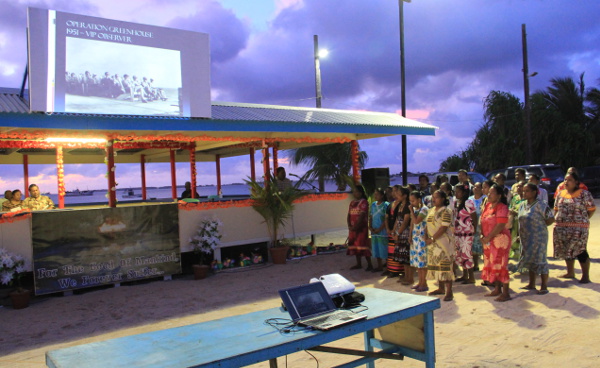
5) Representatives from each irradiated atoll participate in distinctive ceremonies during the Marshall Islands Victims Day Commemorations 2014. Photo: Mick Broderick.
In 2013 in Tahiti we met with long-time campaigners for indigenous Polynesian rights and compensation for the exposure to French nuclear testing, both atmospheric and underground. By contrast, on the mid-Pacific atoll of Kiritimati (formerly Christmas Island) in the nation of Kiribati, we encountered perhaps the most under-resourced yet successfully organised hibakusha community, organically embracing grass-roots engagement to form an active association with members spanning three generations (Broderick 2017).
Like many such disparate hibakusha groups, Kiritimati survivors were unaware of the extent of other survivor communities of nuclear colonialism around the world. While the Kazaks knew of atmospheric tests in continental America, few had heard of the Pacific tests. In central Australia, affected indigenous elders had not heard of French tests in the Pacific or those conducted by Russia or China, and few had heard of Hiroshima or Nagasaki. More surprising was that those on Kiritimati who witnessed scores of British and US thermonuclear tests (1958-62) exploding above or adjacent to their atoll had never been given any official documentation or health checks or later consulted over the belated British 'clean-up' of their homeland (2005-06).
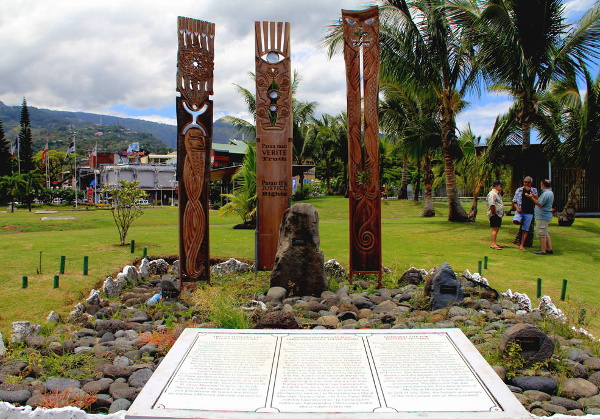
6) A waterfront monument in Papeete commemorating the French nuclear tests in Polynesia, also displaying artefacts donated from other global test sites. Photo: Mick Broderick.
In the developed world ignorance of nuclear tests stemmed mostly from draconian official secrecy provisions constraining those military and civilian participants of nuclear tests from divulging information, even to their spouses or children. We met nuclear veteran groups and individuals in the UK, USA, France, Australia, New Zealand and Fiji and community members affected by nuclear weapons accidents (Palomares, Spain), downwinders (St George, Utah) subjected to fallout, and community members exposed to decades long exposures from plutonium production (Hanford, Washington). Irrespective of national government each group was met with scientific and medical obfuscation, official denials and disinformation.
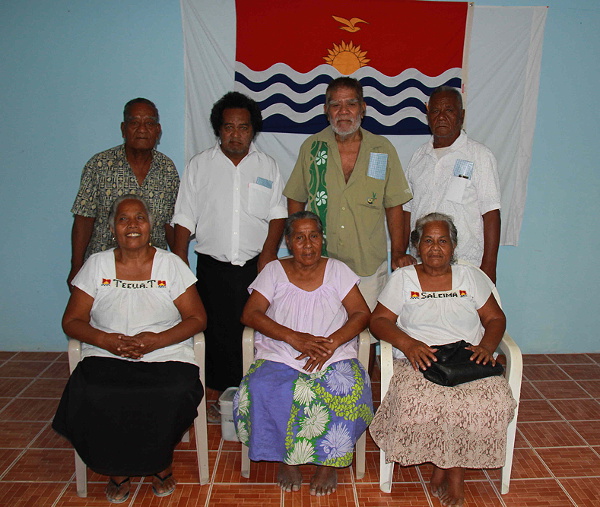
7) Members from the Kiritimati (Christmas Island) nuclear survivors association in 2017 who were present at the time of the UK and US nuclear tests 1958-1962. Photo: Mick Broderick.
The intergenerational parallels between indigenous hibakusha communities and their first-world counterparts were surprisingly similar, despite the disparity in resources (financial, educational, medical and legal). Yet we noticed a general hunger for knowledge and a willingness to share these histories amongst indigenous groups but occasional, lingering indifference from some veterans (less so conscripts) as to the plight of those remote ethnic populations, perhaps as a residual effect of cold war military indoctrination, and possibly from historical unease in participating in the military-industrial complex's global nuclear experimentation, contamination and dispossession of these societies.
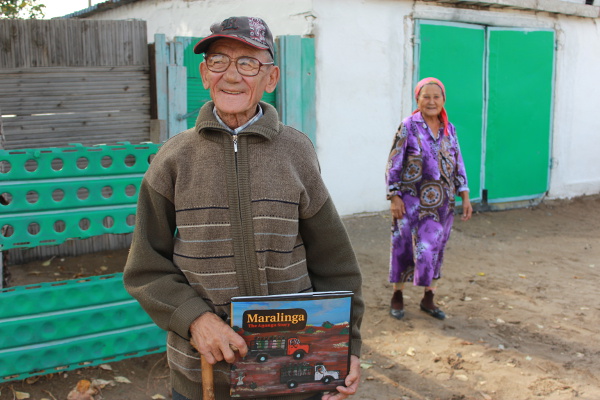
8) Sharing stories: the Global Hibakusha Project donated books such as Maralinga: the Anangu Story to Kazakh (above), Japanese, Marshallese and Kiribati nuclear survivors. Photo Mick Broderick.
The experiences and legacies of nuclear testing are hard to contain, however, radiological contamination from nuclear production and nuclear accidents can be more veiled. Visiting to the site of the Palomares nuclear accident in 2013 was particularly sobering. In 1966 a US nuclear bomber exploded over this small Spanish fishing village while re-fuelling mid-air. Four hydrogen bombs fell from the sky, two landing in the village and two just offshore in the Mediterranean. The two that landed in the village split open spreading plutonium and other dangerous chemicals around the village. While the US staged several partial clean-ups, the sites remain coated with plutonium. While we interviewed many local residents about the experience, standing aside the contaminated sites, separated from schools and houses just yards away by a plastic fence, we witnessed the ongoing contamination that results from shoddy remediation. Given the single, relatively small incident that resulted in the contamination of Palomares, awareness of the ongoing nature of the contamination seemed to have fallen on the shoulders of a few villagers fighting against the larger community desire to encourage tourism.
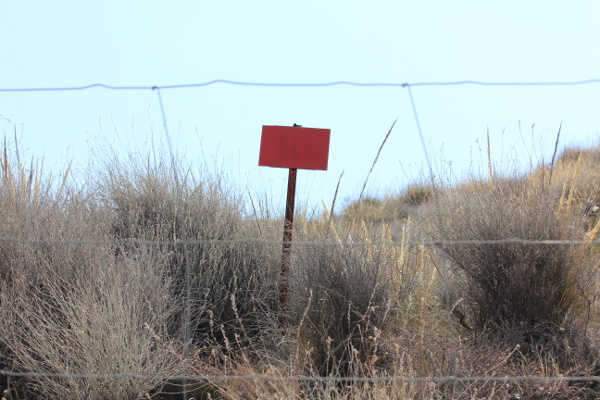
9) A faded "R" for "Radioactive" sign next to a village at Palomares, Spain. Photo: Mick Broderick.
Lack of awareness, with inadequate public information is also evident at sites such as Hanford, Washington, where the US produced most of its plutonium for nuclear weapons, many are aware of the contaminations of the ecosystem, although a significant portion of the local population remains economically dependent on the contracts related to the site, and therefore internalise the official narratives of successful remediation (Brown 2013).
The Workshops
Regardless of how we conducted our inquiries, we could not escape the fact that we were outsiders asking people to share their stories and histories with us, and for whom very little that we did would change their material circumstances, for example--living distant from their homelands, or remaining in contaminated lands. We thought a lot about how we could bring resources into communities rather than simply removing them. Several events led us to begin to design a possible path forward.
First, despite one of us taking up residence in Japan and the other visiting Japan frequently it wasn't until we both gave presentations at the annual Hiroshima and Peace student symposium of Hiroshima City University that an unexpected insight into our future methodology manifested. After listening to moving personal testimony from an elderly male hibakusha an international postgraduate student asked how he had informed his children about his experiences. The hibakusha replied that he had never spoken to his immediate family about the atomic bombing. However, after a pause, he noted that recently at his grandchildren's school he spoke to the group of his experiences, as they were about the same age as he was at the time of the attack. It was 'lightbulb' moment for us. We had understood from the scholarly literature and personal experiences -- whether returning military veterans or meeting with survivors of the Nazi and Rwandan genocides -- both the latency of traumatic responses and a common reluctance to speak was often due to an inverse-victimisation (e.g. survivor guilt) creating shame and/or the repression of experiences. By reaching out to this third (digitally native) generation we might help foster relations within community and also aid with the inter-generational comprehension and reconciliation within individual families.
The second was that we often interviewed people with some family members present. For those living in communities nearby test sites these family members had often heard their elders' stories repeatedly and they themselves were living with the after-effects of the testing. In contrast, for the nuclear veterans, it was often the first time their adult children had heard the stories. We had been very sensitive to how these narratives were transmitted in families, and how they were inherited. The third, and another 'lightbulb' moment came when we were asked to give a talk to a class at the College of the Marshall Islands on Majuro Atoll. The instructor told the students that they would have to write a two-page response paper to our talk, and we saw the whole class full of young people take out their phones and begin to film our talk. As we looked out at the sea of young people all filming us with their phones, we realised that what we were looking at was actually a tremendous resource. We began to design workshops for 3rd generation hibakusha, people whose grandparents had experienced either direct nuclear attack or nuclear testing. Our intent was to hold the workshops for three days to train the participants to conduct oral history interviews with their elders, in their native languages, to edit those interviews, and to create their own digital repositories of the interviews. This way stories could be recorded by family members and passed on within the communities in culturally appropriate ways that could be better preserved.
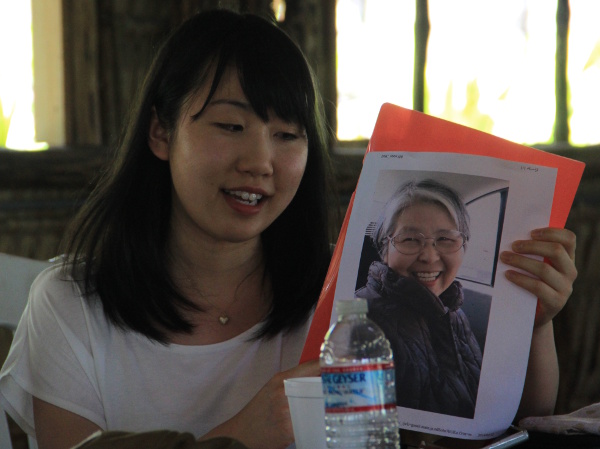
10) Third generation Hiroshima hibakusha, Kana Myoshi, describing her Grandmother's experience. Photo: Mick Broderick.
The First Workshop Marshall Islands 2014
With the generous assistance of the Nuclear Futures Partnership Initiative, led by Creative Producer Paul Brown (Alphaville) and chiefly funded by the Australia Council for the Arts, we held the first of these workshops in the Republic of the Marshall Islands in 2014 on the 60th anniversary of the Bravo nuclear test, which is a national holiday throughout the Marshall Islands: Nuclear Victims and Survivors Remembrance Day. We had 3rd generation participants from the Marshall Islands, Kazakhstan, and Hiroshima along with visiting Nuclear Futures digital artists Jessie Boylan and Linda Dement.
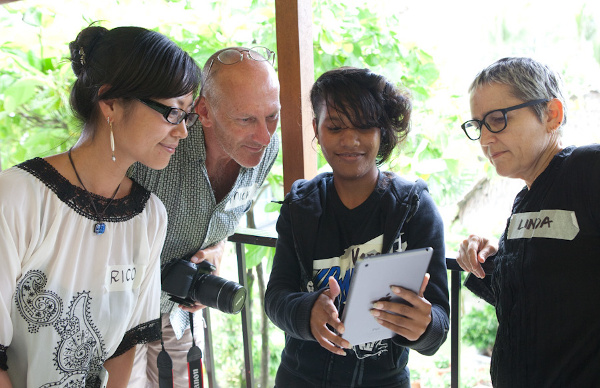
11) Marshall Islands Global Hibakusha Workshop February-March 2014. Participants used iPads to record each other's stories. Photo: Jessie Boylan.
12) SLIDESHOW: Marshall Islands Global Hibakusha Workshop. Photos: the participants.
13) Sharing Stories: Marshall Islands Global Hibakusha Workshop 2014. Participants from Australia, Marshall Islands, Japan and Kazakhstan. Video: Bo Jacobs.
14) Global Hibakusha Project 2014: Marshall Islands workshop messages. Video: Workshop Participants.
Hiroshima: the Second Workshop 2015
The second workshop was held in 2015 in Hiroshima (coinciding with the 70th commemoration of the atom bombings) and included participants from Nagasaki and Hiroshima and from the Yalata Aboriginal community of South Australia, with Nuclear Futures liaison by Ellise Barkley and Rico Ishii (who attended both workshops) as translator-mentor.3
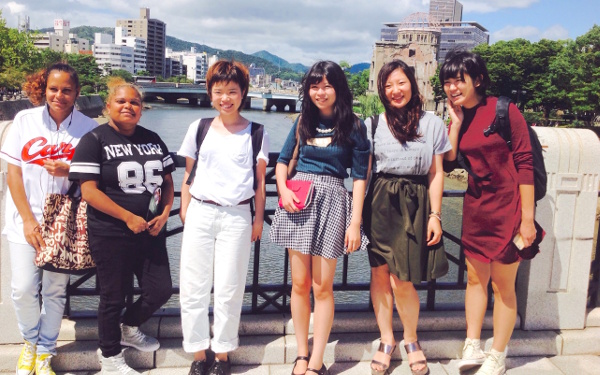
15) Hiroshima Global Hibakusha Workshop 2015. Lorraine Garay and Andrea Windlass from Yalata, South Australia, with Japanese workshop participants Yui Mikoji, Chikako Kamemoto, Kazuho Kubota and Haruka Maekawa. Photo: Ellise Barkley.
16) Inside the Dome (2015). 2014 Marshall Island workshop participant, Kana Myoshi, visits the Genbaku Dome across from the Hiroshima Peace Park to reflect on her grand-mother's experience. (Original video produced in 3D: Stuart Bender and Mick Broderick).
The workshops at Marshall Islands and Hiroshima provided the opportunity for rich cultural exchange and learning, including demonstrated transformative impacts for participants as evidenced by the evaluation of the Nuclear Futures Partnership Initiative.4 Connections made between the Global Hibakusha Project and Nuclear Futures amplified cultural exchange between Maralinga atomic survivor communities and hibakusha groups in both Hiroshima and Nagasaki. For example, the gift of a sculpture from Maralinga communities to the Nagasaki Peace Park in 2016 was a related project with overlap of participants.
Global Hibakusha: past, present and future
The Fukushima Daiichi nuclear disaster in 2011 extended everyone's understanding of what it meant to be an atomic survivor. Although we had already embarked on our Global Hibakusha Project at the time of the Fukushima disaster we deliberately chose not to rush into the area to conduct site visits, preferring to let qualified medical, psychological and social services conduct emergency operations. We did, however, provide expert commentary in the media and academic circles, drawing from our project findings, suggesting an expected repetition of historical hibakusha demonisation by authorities and patterns of official denial and victimisation. Sadly, these observations were soon all too apparent and continue to inform the public debate over recognition, compensation and reparations in Japan and elsewhere.
One of the salient outcomes we have observed in the Fukushima region is the movement by members of the civil population to organise and engage in complex data analysis of the levels of radiological risk that residents now face. Organisations such as Safecast have used crowd funding to place Geiger Counters that are connected to the internet with 4G technology all around the affected region so that anyone with access to the internet can see a realtime map of radiation readings across the area, including up to the boundary of civilian access to the plant site. The emergence of digitally engaged activists as a local response to the Fukushima crisis shows new technologies and methodologies have been developing in response to nuclear crises. Community based clinics such as Mothers' Radiation Lab Fukushima provide radiation exposure related health screenings and state of the art food analysis. Technologically enabled, community-based work is being conducted throughout the region (Kimura 2016).
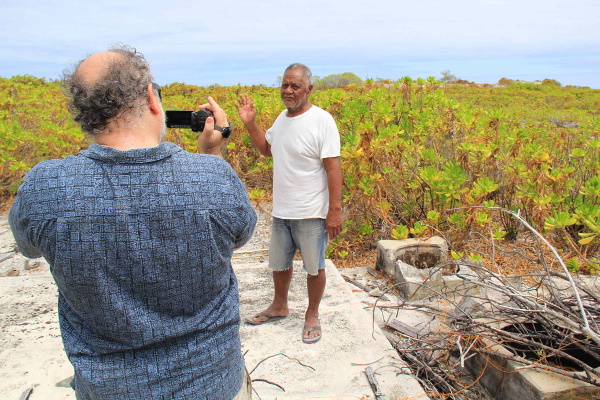
17) Co-author Bo Jacobs recording video testimony in situ at the former airfield bomb preparation building (footings) on Christmas Island. Photo: Mick Broderick.
Meanwhile, hibakusha resilience is slowly improving intergenerationally, as the capacities of new media technologies and social networking enables connection and communication to enhance solidarity and shared knowledges, as well as community-based tracking of the ongoing radiological threats near contaminated areas. It is clear that the capacity to digitise information, such as video recording oral history interviews, has enhanced both information sharing and historical preservation for people globally.
During a recent visit to the former nuclear test sites located on and around Christmas Island (Kiritimati) in the Pacific nation of Kiribati we were able to see ways in which information sharing has evolved, even on this very remote atoll. We had previously met and interviewed veterans who participated in the Christmas Island tests in New Zealand, Fiji, UK and Australia. The Kiribati people living on Kiritimati told us that they had never received any official information that their exposures to radiation or other effects from nuclear weapons testing might have resulted in health problems. Fifty years later a group of British nuclear veterans showed up on Christmas Island with a BBC News crew to report on the anniversary of the tests and the lingering health impacts on the veterans. When speaking with the island's community leaders some of the veterans mentioned that there were likely health effects from the tests afflicting the local community. This was the first time the islanders had ever heard about the dangers of exposures to radiation.
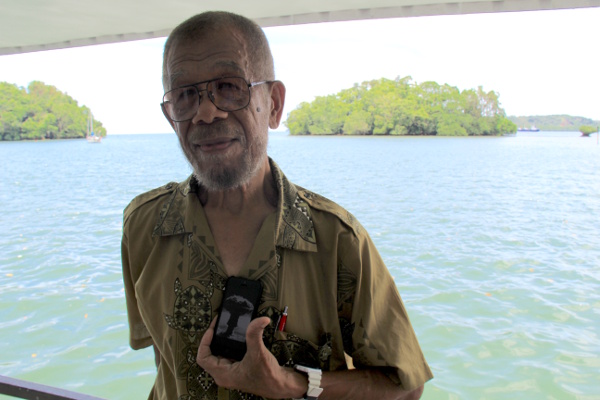
18) Fijian sailor and nuclear survivor, Paul Apoy, holds an image of the Grapple X detonation that he witnessed in late 1957. Grapple X was the first successful British thermonuclear test in the former Gilbert Islands (now Kiribati). Photo: Mick Broderick.
The community on Kiritimati had been effectively cut-off from essential knowledge that should have been provided to them, as well as neither been given health screening nor monitoring for radiation related illnesses. This new knowledge was shared with them through contact with a different hibakusha cohort: the nuclear veterans (Roff 1995). We were able to also pass on to community members more detailed data about the nuclear testing on their atoll, and to conduct oral history interviews with many community members, recordings that are now available to them in digital form and archived. The official information that had previously not been shared with the Kiritimati community is now freely available to anyone with internet access. There are ongoing, informal contacts between nuclear veterans and the Kiribati.
Final Remarks
When historians conduct research, the richest veins of preserved documents from the past are always family histories. Now, family histories include a great deal more photographic images and video. Training 3rd generation hibakusha to interview their relatives and neighbours in a format that can be digitally retained will be a key component in how memory is preserved in these communities. Just as the communities around Fukushima have organised to enhance their understanding of the conditions around them in the aftermath of the nuclear disaster, and their capacity to provide their own expert health analysis and food analysis, other nuclear affected communities will find access to information across exposure cohorts, networking and memory practices through digital technologies. This digital nuclear culture has already begun to play a role in how community is empowered, and how memory is honoured.
Works Cited
Barker, Holly. 2007. "From analysis to action: Efforts to address the nuclear legacy in the Marshall Islands." in Barbara Rose Johnston, ed. Half-lives and half-truths: Confronting the radioactive legacies of the Cold War. Santa Fe: School for Advanced Research Press: 213-248.
Broderick, Mick. 2017. "Story-telling a key to reconnect nuclear veterans with their past". Pacific Beat. ABC Radio. 2017. Web. 5 January 2017.
Brown, Kate. 2013. Plutopia: Nuclear families, atomic cities, and the great Soviet and American plutonium disasters. Oxford: Oxford University Press.
Brown, Paul. 2018. 'Rebellious art: pushing back against the nuclear state'. Unlikely: Journal for Creative Arts. This Volume.
Centers for Disease Control and Prevention and the National Cancer Institute. 2005. Report on the Feasibility of a Study of the Health Consequences to the American Population from Nuclear Weapons Tests Conducted by the United States and Other Nations. Atlanta, GA: CDC.
Church, B. W., J. H. Shinn, G. A. Williams, L. J. Martin, R. S. O'Brien, and S. R. Adams, 1999. "Comparative Plutonium-239 Dose Assessment for Three Desert Sites: Maralinga, Australia; Palomares, Spain; and the Nevada Test Site, USA--Before and After Remedial Action", in Siegfried S. Hecker, Caroline F. V. Mason, Kairat K. Kadyrzhanov, Serge B. Kislitsin (Eds.), Nuclear Physical Methods in Radioecological Investigations of Nuclear Test Sites (Brussels: NATO): 203-219;
International Physicians for the Prevention of Nuclear War. 1991. Radioactive Heaven and Earth: the health and environmental effects of nuclear weapons testing in, on, and above the earth, New York: Apex Press.
Jacobs, Robert and Mick Broderick. 2012. "United Nations Report Reveals the Ongoing Legacy of Nuclear Colonialism in the Marshall Islands." The Asia-Pacific Journal. Web. 19 November 2012.
Jacobs, Robert. 2013. "Nuclear conquistadors: Military colonialism in nuclear test site selection during the Cold War." Asian Journal of Peace-building. Web. Accessed 3 April 2018.
Johnston, Barbara Rose and Holly Baker. 2008. Consequential damages of nuclear war: The Rongelap Report. Walnut Creek, CA: Left Coast Press.
Kimura, Aya Hirata. 2016. Radiation brain moms and citizen scientists. Durham, NC: Duke University Press.
Lifton, Robert J. 1967. Death in Life New York: Random House.
Maclellan, Nic. 2017. Grappling with the Bomb: Britain's Pacific H-bomb tests. Canberra: Australian National University Press.
Nader, Laura and Hugh Gusterson. 2007. "Nuclear legacies: Arrogance, secrecy, ignorance, lies, silence, suffering, action." Barbara Rose Johnston, ed. Half-lives and half-truths: Confronting the radioactive legacies of the Cold War. Santa Fe: School for Advanced Research Press: 299-316.
Prăvălie, Remus. 2014. "Nuclear Weapons Tests and Environmental Consequences: A Global Perspective", AMBIO, Oct; 43(6): 729-744.
Roff, Sue Rabbitt. 1995. Hotspots: The legacy of Hiroshima and Nagasaki. London: Cassell.
Footnotes
- For examples of the wider ranging studies, see: International Physicians for the Prevention of Nuclear War 1991; Church et al. 1999; Centers for Disease Control and Prevention and the National Cancer Institute 2005; and Prăvălie 2014. ↩
- The sentiment was likely first expressed by 1959 Nobel Peace Prize laureate Philip J. Noel-Baker at a 1977 international "symposium on the damage and after-effects" of the atom bombings, and follows Robert J. Lifton's conclusions in his 1967 book Death in Life (Lifton 1967). ↩
- A third workshop scheduled for 2016 at Maralinga in central South Australia, aimed to coincide with the 60th anniversary of the British Operation Buffalo series of nuclear detonations, was regrettably abandoned due to lack of funds. ↩
- For details about the collaboration and workshops see http://nuclearfutures.org/projects/integrating-projects-and-showcases/ ↩

